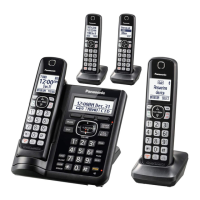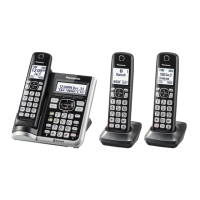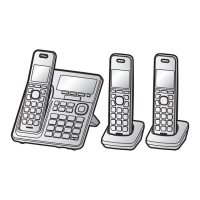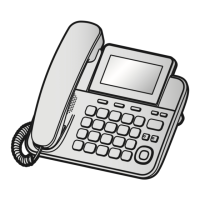
Do you have a question about the Panasonic KX-TGF540 Series and is the answer not in the manual?
| Type | Cordless Telephone |
|---|---|
| Frequency | 1.9 GHz |
| DECT Technology | Yes |
| DECT 6.0 | Yes |
| Number of Lines | 1 |
| Call Blocking | Yes |
| Speakerphone | Yes |
| Intercom | Yes |
| Caller ID | Yes |
| Talking Caller ID | Yes |
| Call Waiting | Yes |
| Display | LCD |
| Keypad on Base | Yes |
| Weight (handset) | 0.25 lbs |
Details the different models and their quantities.
Lists the supplied accessories for the product.
Provides information on optional accessories for purchase.
Notes on design changes and product illustrations.
How to add optional handsets to extend system capability.
Explains the meaning of various symbols found on the equipment.
Crucial safety precautions to prevent injury and property loss.
Safety guidelines related to product installation and location.
Precautions for safe operation and maintenance of the unit.
Advice for users with medical devices regarding RF energy.
Specific safety advice for installing the telephone wiring and locating the unit.
General safety precautions for using the product to reduce risks.
Tips for optimal base unit placement and reception quality.
Guidelines for placing the product in suitable environmental conditions.
Instructions for cleaning and maintaining the product's appearance.
Recommendations for protecting private information before disposing of the product.
General notices regarding product design and compliance.
Technical details and operating conditions of the product.
Step-by-step guide for connecting and preparing the unit for use.
Instructions on how to safely remove the battery from the handset.
Details on how to charge the handset batteries and battery level indicators.
Identifies and explains the functions of handset and base unit controls.
Labels and functions of controls on the base unit.
Explains the meaning of icons displayed on the handset.
Overview of menu structure and feature codes.
How to change the display and voice guidance language.
Selects the language for system guidance and announcements.
Instructions for setting the current date and time on the unit.
Guide to recording a personalized greeting message.
Options for configuring dialing mode and other unit settings.
How to set up alerts for low battery status.
Configure the interval for low battery announcements.
Instructions for initiating calls using the handset or base unit.
How to redial previously called numbers.
Procedure to remove entries from the redial list.
How to make calls directly from the base unit.
How to change volume levels during a call.
How to insert pauses for dialing access numbers or PINs.
Guide to receiving incoming calls on handset or base unit.
How to set the volume for incoming calls.
Temporarily mute the handset ringer with a single button press.
Explains features like Hold and Mute during a call.
How to place an ongoing call on hold.
How to temporarily silence the microphone during a call.
Using the flash function for PBX features or services.
How to manage calls when using call waiting services.
How to enable tone dialing for rotary/pulse lines.
Improves sound clarity in areas with interference.
Reduces background noise for clearer conversations.
Enhances voice clarity for easier understanding.
How to join an existing conversation on another unit.
Procedures for transferring calls and setting up conference calls.
How to make internal calls between units.
Steps to initiate an intercom call from handset or base unit.
How to respond to an incoming intercom call.
Automatically answer intercom calls without pressing buttons.
How the handset powers the base unit during a power failure.
How to make calls when the unit operates on backup power.
How to answer calls during a power failure.
How to block unwanted calls and add numbers to the block list.
Methods for blocking specific numbers or number ranges.
Important recommendation for storing 10-digit numbers.
How to block numbers directly from the caller list.
How to block calls from private or unknown callers.
Choose whether to hear the first ring for blocked calls.
How to manage entries in the call block list.
Procedure to remove all entries from the call block list.
How to add, store, and manage contact entries.
Step-by-step guide to adding new contacts.
How to input names and characters for phonebook entries.
Save numbers from the redial list into the phonebook.
Save incoming call details directly to the phonebook.
How to modify existing phonebook entries.
How to organize phonebook entries into groups.
Customize group names and assign specific ring tones.
How to search and make calls from stored phonebook entries.
How to delete individual or all phonebook entries.
Dial stored numbers from the phonebook while on a call.
Assign phone numbers to speed dial keys for quick access.
Methods to assign numbers to speed dial keys.
How to edit names, numbers, and groups in speed dial.
How to remove entries from speed dial.
How to view speed dial entries and initiate calls.
How to access features via menus or direct command codes.
Accessing and managing phonebook entries.
Settings related to the answering system functions.
Settings for recording and managing greeting messages.
Accessing voicemail services from the unit.
Features for making calls between units.
Setting the unit's date, time, and alarm functions.
Managing speed dial entries and settings.
Enabling voice announcements for incoming callers.
Setting up alerts for low battery status.
Options for blocking unwanted calls.
Settings for voicemail access and tone detection.
Customizing names for individual handsets.
Automatically editing caller ID numbers.
How to register new handsets or other units to the base.
How the unit operates during a power outage.
Setting the language for display and voice announcements.
Features for monitoring rooms remotely.
Managing phonebook entries.
Configuration options for the answering system.
Features for blocking unwanted calls.
Enabling automatic intercom calls between units.
Automatically editing caller ID numbers.
Accessing customer support information.
Setting and managing alarm times and memos.
Setting periods when the unit will not ring.
How to activate or deactivate silent mode.
Feature to monitor rooms remotely.
Configuring the baby monitor feature for monitoring.
How to listen in on a room using another unit.
How to monitor rooms remotely via phone call.
Deactivating the baby monitor feature.
Modifying phone numbers for remote monitoring.
Removing numbers used for remote monitoring.
Adjusting the sensitivity to trigger the baby monitor.
How to respond to a baby monitor alert.
Customizing names for individual handsets.
Enabling the display of handset names in standby mode.
Instructions for adding additional units like handsets.
Pairing a new handset with the base unit.
Re-registering a handset to the base unit if it's not recognized.
Removing a handset's registration from the base unit.
Requirements and basic usage of the Caller ID feature.
Details on displaying caller information and handling calls.
How the unit indicates and manages un-answered calls.
How stored names appear when a Caller ID matches a phonebook entry.
Enabling voice announcements for incoming callers.
Announces stored names for incoming callers.
Information about the list of incoming calls.
How to view call history and return calls.
Modifying phone numbers in the caller list, e.g., removing area codes.
Automatic adjustment of caller ID formats based on call history.
Deleting specific entries from the caller list.
Clearing the entire caller list.
Overview of the unit's answering and recording capabilities.
Details on total recording time and message capacity.
How to activate or deactivate the answering system.
Using pre-recorded or custom greeting messages.
Step-by-step guide to record a personal greeting.
How the unit uses pre-recorded greetings.
Revert to default greeting messages.
How to listen to your recorded greeting.
How to play back recorded messages on handset or base unit.
Playing messages using the base unit controls.
How to call back callers from the message playback.
Procedure to delete all recorded messages.
Playing messages using the handset controls.
Controls available while listening to messages.
Methods to erase all recorded messages.
Settings for alerts when new messages arrive.
Base unit beeps to notify of new messages.
Get notified of new messages via a phone call.
Setting a number for remote notification of new messages.
Activating or deactivating the new message alert feature.
Modifying the phone number for message alerts.
Removing the phone number for message alerts.
Setting up a code for secure remote message access.
Accessing messages remotely after receiving an alert.
Operating the answering system remotely using a touch-tone phone.
Setting and managing the code for remote access.
How to delete the remote access code.
Steps for remotely accessing system functions.
Using voice prompts for remote operation.
Dial key commands for remote answering system control.
Steps to remotely access and control the answering system.
General settings for the answering system.
Listening to callers as they leave messages.
Adjusting how many rings before the unit answers.
Setting the maximum duration for recorded messages.
Configuring the unit to only play greetings, not record messages.
Information about voicemail services from phone providers.
How to save your voicemail access number for easy dialing.
Removing the stored voicemail access number.
How the unit detects voicemail tones.
Activating or deactivating voicemail tone detection.
How to listen to voicemail messages using the unit.
Instructions for mounting the base unit on a wall.
Further details and diagrams for wall mounting the base unit.
Explains common error messages and their solutions.
General troubleshooting steps for common problems.
Troubleshooting issues related to menu navigation and language.
Troubleshooting battery charging problems.
Troubleshooting issues related to calls and intercom functions.
Troubleshooting issues with Caller ID and voice announcements.
Troubleshooting problems with the answering system's recording and operation.
Troubleshooting voicemail display messages.
What to do if the unit is exposed to moisture or liquid.
Compliance information regarding FCC regulations and RF exposure.
Continued information on FCC compliance, RF exposure, and device operation.
Information on hearing aid compatibility.
Information on how to shop for accessories and contact customer support.
Details of the product's limited warranty coverage and terms.
Specific warranty coverage for parts and labor.
How to submit a product for repair service online or by mail.
Exclusions and limitations of the product warranty.












